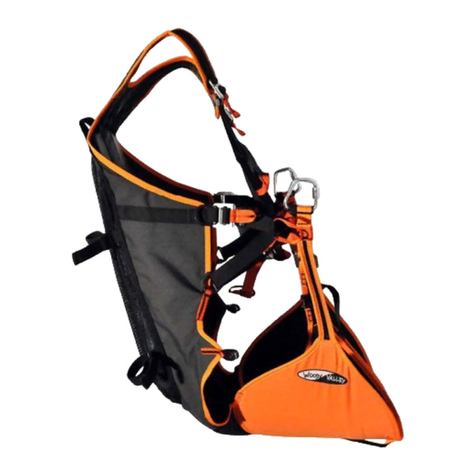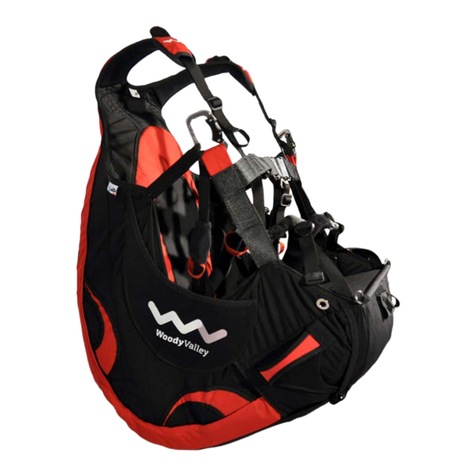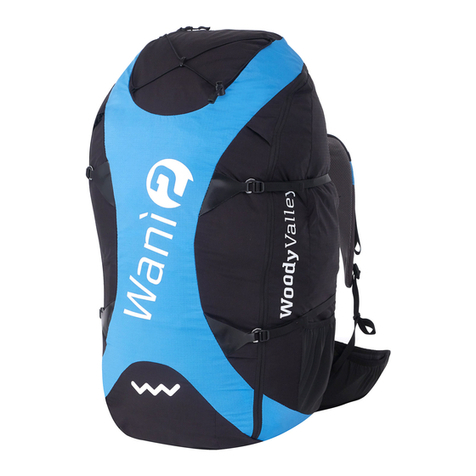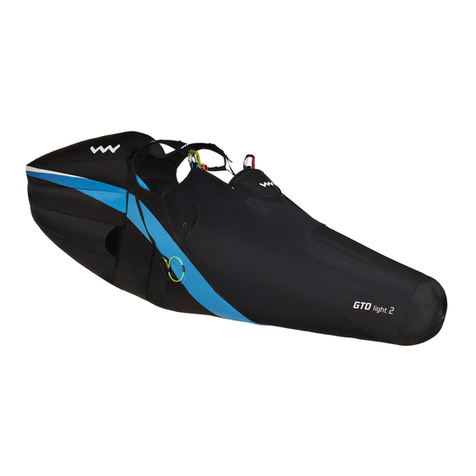
Wanì 3 - user manual
7
ENG
1.2- Protection and safety
With this new harness, we are once again recommending our highly te-
sted, consolidated self-inating air bag system, which consists of a steel
spring that generates the force needed to expand the air bag, making it
ready for potential impact at all times. This means that your protective
capacities are at 100% before you even start your take-off run, and that
they remain as such for the entire ight, until you fold up the harness to
stow it in the rucksack. The spring also guarantees a consistent form for
the airbag and therefore performance over long periods of time, in any
humidity, temperature or prolonged storage in the rucksack. Light weight
and reduced volume (once the harness is folded) are two more advanta-
ges provided by the self-inating spring system. This system combines the
best characteristics of current protection systems (airbag and foam pro-
tection).
Certied side protection is available as an option, inserted in a special rear
containment pocket.
WANì 3 is equipped with the T-Lock system and a new non-elastic strap
system for tightening the shoulder straps.
Harness Impact Pad Report
Inspection certificate number: PH_286.2019
Manufacturer data: Sample data:
Manufacturer name: Woody Valley srl Name impact pad: n/a
Representative: Simone Caldana Impact pad intgrated: Yes
Street: Via Vienna 92 Impact pad type: Airbag
Post code place: 30121 Trento Serial number: n/a
Country: Italy Weight of sample [kg]: n/a
Harness model: Wani Light 2
RH [%] 56
[hPa] 974.4
Summary of Impact pad test (1)
Test id
(3)
Duration at 38 [g]
in [ms]
(4)
Duration at 20
[g] in [ms]
(5)
Diff. of test 1
and 2 [%]
(6)
17.37 0.00 0.00 -2.87 POSITIVE
PR V26.80 0.00 7.50 1.01 POSITIVE
Manufacture Instrument Type no S/N Validity Calibration
Burster/MTS Accelerometer 100 g 89010-100 1263567
JDC elec Geos n°11 Skywatch Geos n°11 22
This declaration must not be reproduced in part without the written permission of AIR TURQUOISE SA.
The validation of this test report is given by the signature of the test manager on the Inspection Certificate no 94.20
Test sample attached to dummy in flying
position, without emergency parachute
Test sample attached to dummy in flying
position, Include emergency parachute
(2)
(1) Calculated value in tests reports include the value minus the uncertainty (on safe side) / The uncertainty stated is the expanded uncertainty obtained by multiplying the standard
uncertainty by the coverage factor k = 2. The value of the measurand lies within the assigned range of values with a probability of 95%.
(3) Maximum peak of impact should be less or equal to 50 [g], (4) If any, the maximum duration in at 38 [g] should be less or equal to 7 [ms], (5) If any, the maximum duration in at 20 [g]
should be less or equal to 25 [ms].
(6)
The test should be done twice, and the 2nd test the maximum peak should not differe more than 20% from the first test, maximum peak.
(2) The dummy is lifted minimum up to 1.65 m, and impact pad is mounted on. Where the impact occurs, measure distance from bottom of impact pad to ground.
BR | rev 03 | 02.05.2019 Page 1 of 2 ISO 94.22
Inspection certificate number:
PH_286.2019 Name impact pad: n/a
Test results of Impact pad test
P1 P2 PR1 PR2
Maximum Peak of impact [g]
Impact duration at +38 [g] in [ms]
Impact duration at +20 [g] in [ms]
Uncertainty k=2[g]
Difference of test 1 and 2 [%]
100.00 97.13 100.00 103.91
without emergency parachute
include emergency parachute
-5.00
5.00
15.00
25.00
35.00
45.00
10.50 10.70 10.90 11.10 11.30 11.50 11.70 11.90
[g]
Time [s]
P1 20g 38g
-5.00
5.00
15.00
25.00
35.00
45.00
11.50 11.70 11.90 12.10 12.30 12.50 12.70 12.90
[g]
Time [s]
P2 20g 38g
-5.00
5.00
15.00
25.00
35.00
45.00
9.00 9.20 9.40 9.60 9.80 10.00 10.20 10.40
[g]
Time [s]
PR1 20g 38g
-5.00
5.00
15.00
25.00
35.00
45.00
7.50 8.00 8.50 9.00 9.50 10.00
[g]
Time [s]
PR2 20g 38g
RE | rev 01 | 09.03.2018 Page 2 of 2 ISO 94.22






































